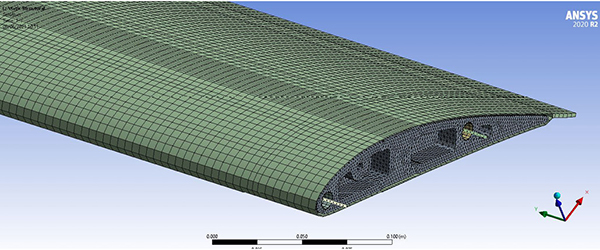
Analysis results showing displacements in smooth gradient in the flap mechanism of Team Pie Aeronefs’s UR-1 plane. Analysis done in Ansys Mechanical. Image courtesy of Pie Aeronefs.
Latest News
August 3, 2021
Marc Umbricht and his colleagues founded Pie Aeronefs SA in 2020 with an ambitious goal: to design and make lightweight and zero-emissions aircrafts by 2026.
“When you are lightweighting, you target the forces you know you need to resist,” says Umbricht, CEO and CTO of Pie Aeronefs. “But the risk is, there are also forces you aren’t considering.”
This is, in essence, the dilemma in all lightweighting projects. How do you retain sufficient structural muscles in the design to ensure it can survive not only routine events but also the unlikely but probable events? A smartphone designer must make sure the phone can survive not only the day-to-day operations but also the occasional mishaps, such as the user dropping the phone onto a concrete floor or into a water-filled bathtub.
Similarly, Umbricht and his engineers need to prepare their plane not only for the known forces but also for the dreaded scenarios, such as a midair collision or a crash landing.
If lightweighting is the remedy to over-building, it’s also a doorway to the danger of under-building. As he recounted the decision-making process in the construction of Pie Aeronefs’ (Team Pie Aeronefs) UR-1 plane for the Air Race E Challenge, Umbricht revealed ways to add safeguards in lightweighting to avoid under-building.
Motorsports for Electric Planes
Described as “the first ever all-electric airplane race,” Air Race E pits eight planes against one another in a race around an oval circuit.
“The spectacular, quick, action-packed race will see speeds of 400 km/h [250 mph] around a tight circuit just 1.5 km end to end. The first race series will go ahead in 2022,” the organizers promise on their website.
“When you’re in flight, you deal with the four forces of flight: thrust, drag, lift and weight. A good balance of these four gives you a steady flight,” explains Umbricht. “If you were to suddenly increase the rudder input, the aircraft would yaw at a certain rate, causing a torque between the wing and the fuselage. This is not a particularly important consideration in most planes, but in ours, the mass includes the batteries in the wings, so it was a major factor.”
Traditional aircrafts do not have wings loaded with battery packs. But Team Pie Aeronefs’ UR-1 does. The added weight also affects the landing gear’s operations. Such design elements present additional challenges to the simulation and lightweighting tasks.
Preparing for the Surprises
Team Pie Aeronefs’ UR-1 is designed to meet the European Union Aviation Safety Agency’s (EASA) CS-23 regulations for normal, utility, aerobatic and commuter aeroplanes. The rules stipulate the planes must be able to handle “gust upsets, inadvertent control movements, low stick force gradient in relation to control friction, passenger movement,” and a host of other events.

“At low altitude [where the race will take place], gust speed tends to be much lower than at high altitude,” says Umbricht. That was another design consideration.
The team also had to consider flight collision events. “These are violent events where 400 to 600-kg objects crash into each other at high speed,” says Umbricht.
In a race where all planes are flying in the same direction, the accidents “probably won’t be head-on collisions,” he reasons.
In theory, an airframe could be designed to survive such an event with robust internal ribs and reinforcements, but the weight of it would make the design impractical, especially for a racing aircraft.
Measuring Risks
In aircraft design and engineering, assigning certain safety risks as “acceptable” or “tolerable” based on probability is routine; though the thought might make a frequent flyer queasy.
“We have to characterize probable events as very likely, unlikely, very rare and never going to happen,” says Umbricht. “So we design the aircraft to have no degradation in performance when it encounters a likely event. But we also have to accept that in case of a highly unlikely event, the result might be hull loss and fatality.”
To offset the risk accepted, engineers included certain mitigation strategies, such as a crash helmet, a quick-detaching canopy and a parachute.
Topology vs. Material
In seeking opportunities to reduce the weight of the craft, engineers chose to exclude the airframe protecting the pilot. This leaves the wings as the obvious target regions. However, the battery-mounted wings have limited options in topology-driven lightweighting.
“So our lightweighting method was based on materials. We made the ribs out of woods—specifically, birch plywood,” says Umbricht. “Because these are natural materials, [finite element analysis (FEA)] programs couldn’t adequately characterize them. So we had to conduct a series of destructive tests.”
Most FEA software includes steel, aluminum, plastic and other standard materials in a dropdown menu to choose from. But the library rarely includes natural materials, such as wood, due to the available variety. Furthermore, the strength, bending behaviors and breaking modes of birch plywood could be specific to the supplier and the source region; therefore, physical testing remains the best approach to understand its character.
Digital vs. Physical
Team Pie Aeronefs used Ansys Mechanical, a structural analysis software package for modeling complex materials, large assemblies as well as linear and nonlinear behaviors. The software allows the team to find the optimal layup of the composite laminates that function as the skin covering the wings. It also lets them simulate the wings’ reaction to the various critical stress loads.
A comparison of the failure modes predicted by the FEA software and those discovered in the physical tests of the wing assembly’s mockup, gave the engineers confidence in the design.
“In one of the destructive tests, the rib broke on the opposite side of the applied load, which made no sense,” Umbricht says. “Most likely, it was because the stress flowed through the fixtures to the opposite side.”
In Team Pie Aeronefs’ experience with the UR-1, FEA software correctly predicted the global region of the failure, but the physical tests revealed the micro regions and specific modes of the failure.
Umbricht believes the key to lightweighting is the ability to accurately describe the operating conditions of the craft in the FEA software. The simulation is relatively simple for fixed-wing airplanes, as the operating conditions are well understood. Even edge cases, such as bird strikes, are well-known.
“For us, it came down to doing due diligence to find all the edge cases that are applicable to us, and designing the craft that can react to them,” says Umbricht.
More Ansys Coverage
Subscribe to our FREE magazine, FREE email newsletters or both!
Latest News
About the Author
Kenneth Wong is Digital Engineering’s resident blogger and senior editor. Email him at [email protected] or share your thoughts on this article at digitaleng.news/facebook.
Follow DE





